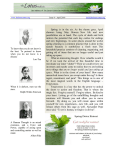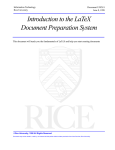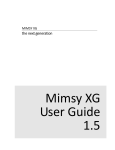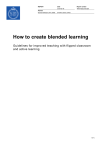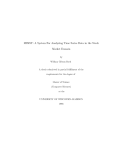Download Assess Your Grammatical Acumen
Transcript
Writing Clinic Assess Your Grammatical Acumen BY SUSAN MCCLOSKEY G rammar is the user’s manual that comes with a language. It helps writers shape their thoughts into sentences that mean something to readers. You may not often consult this manual, for the very good reason that you don’t need to. Even if you have forgotten what a past participle is or cannot distinguish a coordinate from a subordinate conjunction, you probably use these grammatical elements accurately more often than not. So, whether you picked up grammar on the fly or learned it by diagramming sentences under Miss Grundy’s watchful instruction, you may be thinking right now that the last thing you want to do is read this essay. Before you act on that thought, however, take the Grammar Quiz. The errors represented in the quiz are those I encounter in almost every document I review for my clients, no matter what their practice area or level of experience. Think of them as the Lawyers’ Top Ten. If you recognize what is awry in every sentence and can set things to rights, read no further. But if even one sentence looks just fine to you, or if you’re curious about the grammatical errors that other legal writers repeatedly commit, read on. For the grammarphiles among you, I’ve provided a Bonus Question to test your recall of the parts of speech and their functions in sentences. Along the way, perhaps even grammarphobes will conclude that grammar fosters something more than the chilly virtue of correctness. It makes intelligible the interchange between writer and reader in which lawyers daily engage. Here’s the quiz. You can check your answers on page 33. GRAMMAR QUIZ Identify and correct the errors in the following sentences. 1. Ordinary socializing and flirtation fails to satisfy the severity test of a valid sexual-harassment claim. 2. What type of damages are available for recovery against a builder under these circumstances? 3. Once a moving party meets their burden, the burden shifts. 30 4. Formal title to the property would remain with the wife, which may be unpalatable to the husband. 5. Whether due process was honored; whether the parties’ rights to be heard and represented were fully exercised; whether the court’s discretionary ruling was reasoned or arbitrary: This can be determined only on a case-by-case basis. 6. Bradley’s client said she understood the charges a few times during the conversation. 7. To prove actual malice, the defendant must have known the statements were false or published them with reckless disregard despite knowing they were false. 8. Neither the report of Dr. Farragut nor Dr. Rider contains the requisite information. 9. In the case of the Loan, (1) there is an express loan, (2) the terms of which are set forth in the Note, (3) which interest rate exceeds the permissible rate of 20%. 10. Like Sheffield, the adoptive parent contracted orally, but not in writing, to raise his wife’s child as his own. 11. Bonus Question: For the words you do not recognize in the first stanza of Lewis Carroll’s Jabberwocky, identify their parts of speech (e.g., noun, verb, adjective) and their function (e.g., subject, verb, direct object). ’Twas brillig, and the slithy toves Did gyre and gimble in the wabe; All mimsy were the borogoves, And the mome raths outgrabe.1 ***** SUSAN MCCLOSKEY is the president of McCloskey Writing Consultants in Verbank, NY. Her firm offers writing seminars and writing and editorial services to law firms and law departments nationwide. She received her Ph.D. from Princeton University and was a tenured professor of English literature at Vassar College. Her firm’s Web site address is <www.mccloskeywriting.com>. Other Writing Clinic articles by Ms. McCloskey have appeared in the Journal in the November 1998 and 1999 issues, and the November/December issues in 2000, 2001, 2002 and 2003. Reprinted with permission from the New York State Bar Association Journal, September 2004, Vol. 76, No. 7, published by the New York State Bar Association, One Elk Street, Albany, New York 12207. Journal | September 2004 The errors in sentences 1 through 10 fall into three categories: (1) problems of agreement, in which the writer has obscured the relationship between subject and verb, or pronoun and antecedent; (2) problems of modification, in which the writer has mishandled the modifiers that elaborate the sentence’s core meaning; and (3) problems of coordination, in which the writer has mismatched structures that should match or tried to compare incomparable things. Sorting the problems in this way makes them easier to recognize; once you’ve recognized them, solving them is a snap. Problems of Agreement: Subject and Verb (# 1–2) Among the rules of grammar, those pertaining to agreement are fundamental. Every reader is confused every time a writer obscures the relationship between a sentence’s functional elements – its subject and verb, or its pronouns and the nouns they replace. Even the grammar-checking program on your computer reacts to simple instances of these problems, sending out green squiggles to summon you to greater care. The first rule of agreement requires that the subject and verb of a sentence agree in number. A singular subject takes a singular verb; a plural or compound subject, a plural verb. In Sentence 1 of the Grammar Quiz, Ordinary socializing and flirtation fails to satisfy the severity test of a valid sexual-harassment claim, the writer broke this rule by giving a compound subject (ordinary socializing and flirtation) a singular verb (fails). This error is especially puzzling, because the writer almost certainly would never write Paul and Fred wishes to jettison their voluble silent partner. Why did he slip into an error here? Perhaps ordinary socializing and flirtation struck him as a unitary concept, like the compound-looking but singular-meaning subject of this sentence: Having your cake and eating it too is a delectable impossibility. Offices across the land would be very different places, though, if there were no distinction between saying hello to a co-worker and blowing him or her a kiss. It is prudent and courteous to honor that difference and grammatically correct to write the plural verb fail. In Sentence 2, the writer mistook the subject, letting the noun closest to the verb determine the verb’s number: What type of damages are available for recovery against a builder under these circumstances? The problem is that the grammatical subject is not the plural damages, but the singular type. You can avoid this routine error by remembering that the object of a preposition cannot be the subject of the verb. This rule disqualifies damages, recovery, builder, and circumstances, all of which follow prepositions. By process of elimination, you’re left with type, a choice that is semantically as well as grammati- Journal | September 2004 cally accurate. The correct pairing of singular subject and singular verb clarifies that the writer is interested in the categories of damages, not in the dollar amount of the plaintiff’s possible award. In response to her question, she expects actual damages or perhaps punitive damages, not $50,000. Agreement maximizes the likelihood that she’ll get the response she is seeking. Problems of Agreement: Nouns and Pronouns (# 3–5) Like subjects and verbs, pronouns and the nouns they replace must agree in number. But the second rule of agreement is more complicated than the first, because the pronoun must also agree with its antecedent in person and gender. A pronoun in the second person cannot, for instance, replace a noun in the third, as here: If a person wants to thrive in solo practice, you had better get used to long hours and unpredictable revenue. Nor, as a growing consensus holds, can a pronoun of one gender replace a noun that includes both genders in its meaning. The illustrative sentence above becomes grammatically accurate but politically suspect when you replace person with only the masculine he or only the feminine she. The writer of Sentence 3 ran up against this problem and solved it in the least satisfactory way: Once a moving party meets their burden, the burden shifts. He wished to avoid the ponderousness of Once a moving party meets a moving party’s burden and the ungainliness of replacing moving party with his or her. So he seized grammar by the throat, gave it a good throttle, and replaced a singular noun with the plural pronoun their. Until English evolves a singular, third-person pronoun to do the job that he alone used to do, you will have to be resourceful if you wish to be grammatical. If using his or her displeases you, you must improvise. You might remove the possessive pronoun altogether: Once the moving party meets the burden, the burden shifts. Or you might shift from the singular to the plural: Once moving parties meet their burden, the burden shifts. In some contexts, you can use we, you, or one to reach the safe harbor of gender neutrality. In this essay, I have chosen to be evenhanded instead of neutral, using the masculine pronoun for writers of the odd-numbered sentences in the Grammar Quiz and the feminine pronoun for writers of the even-numbered ones. An ideal solution? No. A reasonable expedient? I think so. Sentence 4 illustrates the forlorn circumstance of a pronoun without a noun to relate to: Formal title to the property would remain with the wife, which may be unpalatable to the husband. Does the relative pronoun which refer to title, property, or wife? The first possibility makes no sense, because a title isn’t even metaphorically unpalatable. Property makes sense only if we imagine an unusually ugly house and a husband of exacting taste. Even in 31 the context of divorce proceedings, it’s unlikely that wife is the intended referent. The writer almost certainly meant which to refer to the idea she expressed in the main clause. But a pronoun can’t do that job, because it derives its meaning not from phrases and clauses, but from its one-to-one relationship with a noun. Since title, property, and wife are the only nouns preceding the pronoun, and none tells us what the husband may find unpalatable, the writer must rephrase to eliminate the meaningless which: Formal title to the property would remain with the wife, an arrangement that the husband may find unpalatable. Or, Formal title to the property would remain with the wife. The husband may dislike this arrangement. Unlike Sentence 4’s which, which has nothing to refer to, Sentence 5’s this has more to refer to than it can reasonably handle. In the long subclause, the writer specifies a three-pronged test of a court’s just dealing: Whether due process was honored; whether the parties’ rights to be heard and represented were fully exercised; whether the court’s discretionary ruling was reasoned or arbitrary. He meant the singular this in the main clause to refer to all three prongs – something that a singular pronoun cannot do: This can be determined only on a case-by-case basis. There are good and better ways to solve this problem. The plural These would be clearer than the singular This, but not perfectly clear. Demonstrative pronouns (this, that, these, and those) require for clarity the demonstration that their name specifies. At the fish market, for instance, the proprietor knows what you mean when you say I’ll take six of those, because you can point to the salmon fillets. The identical instruction over the telephone would certainly prompt a request for clarification. In writing as in telephoning, you are unable to point, so the demonstrative pronouns do you little good. Utility and clarity alike increase when you place a noun after every written use of this, that, these, and those. In Sentence 5, These elements would be clearer than These alone. Pronouns cease to be troublesome when you remember what they are and use them to do the work they’re suited to do. Pronouns take the place of nouns so that you never need to write a sentence like this one: John lost John’s case when John’s star witness left town on the day John planned to place John’s star witness on the stand. As long as every pronoun you write has an unambiguous relationship with a noun – not a phrase, not a clause, not everything that precedes the pronoun – all will be well. You make that relationship evident when the pronoun and its related noun agree in person, number, and gender. Problems of Modification (# 6–7) When Western Union charged by the word, people who sent telegrams knew how to reduce a thought to its 32 essential elements – an implied subject, a verb, and a participial adjective (Got married) or an implied subject, a verb, and a direct object (Send money). In the era of email, writers can afford to be more expansive in their messages – to indicate, at the very least, whom they married or how much money they need. Modification denotes this fleshing out of a sentence’s bare bones – the use of words, phrases, and clauses to tell the reader more about the sentence’s essential elements of subject, verb, and object. Observe the Zen-like statement, The good is reached, grow through modification into one of Justice Holmes’s most famous sentences. First, the noun good acquires two modifying adjectives: The ultimate good desired is reached. This clause then takes on a pair of prepositional phrases: The ultimate good desired is reached by free trade in ideas. Then the modifying clauses arrive to elbow the thought toward increasing clarity. First, a new clause absorbs and subordinates the existing clause: Men may come to believe that the ultimate good desired is reached by free trade in ideas. This new clause shoots forth a subclause: . . . they may come to believe even more than they believe the very foundations of their own conduct that the ultimate good desired is better reached by free trade in ideas. When this modified main clause finally yields a pair of appositive subclauses, Holmes’s thought is expressed: [W]hen men have realized that time has upset many fighting faiths, they may come to believe even more than they believe the very foundations of their own conduct that the ultimate good desired is better reached by free trade in ideas – that the best test of truth is the power of the thought to get itself accepted in the competition of the market, and that truth is the only ground upon which their wishes safely can be carried out.2 Justice Holmes certainly did not build this sentence in the word-phrase-clause order I’ve suggested, but he needed all three kinds of modifiers as he wrestled with his thought and pinned it to the page. One of the pleasures of writing springs from these transformations of vague notions into precise ideas. Of all the exercises of judgment that inform the crafting of a fine sentence, few require more care than the writer’s decisions about which elements of a sentence to modify, how to modify them, and how extensively to do so. In legal prose, carelessness on this score shows up most often in misplaced and dangling modifiers. Sentence 6 of the Grammar Quiz represents the problem of a misplaced phrase: Bradley’s client said she understood the charges a few times during the conversation. The Journal | September 2004 modifying phrase a few times during the conversation should tell us how often and in what circumstance the client said; in its current place in the sentence, it tells us instead about the client’s intermittent comprehension of the charges. As soon as the writer moves the modifier closer to what it actually modifies, the sentence makes a different sense – in this case, one more flattering to Bradley’s client: A few times during the conversation, Bradley’s client said she understood the charges. Sentence 7 contains a dangling modifier, a problem so common in legal prose that even skillful writers slip into it now and then: To prove actual malice, the defendant must have known the statements were false or published them with reckless disregard despite knowing they were false. Surely the last thing the writer expects the defendant to do is to prove his or her own actual malice. That task falls to the allegedly libeled plaintiff, who doesn’t appear in the sentence except as the implied subject of the infinitive phrase. For the sentence to make sense, the implied subject and the stated subject of the main clause must correspond. The easiest solution is for the writer to alter the main clause by replacing defendant with plaintiff: To prove actual malice, the plaintiff must show that the defendant knew the statements were false. Most legal writers need to keep in mind only two rules about the grammar of modification: (1) Give every modifier something it can reasonably modify, and (2) place modifying words, phrases, and clauses as close as possible to what they modify. Then you’ll be able to express even your most intricate thoughts with Holmesian exuberance and not lose your reader along the way. Coordination: Parallelism (# 8–10) When grammatical elements in a sentence perform the same function, they should take the same form. Even without brushing up your Shakespeare, for instance, you know that Hamlet did not say, To be, or stop being, that is the question. That sentence just doesn’t sound right. The conjunction or links a pair of alternatives, and you expect each alternative to match the other in form: To be, or not to be. Many structures widely used in legal prose call for matches as exact as Hamlet’s famous infinitives. You need parallel constructions when words, phrases, or clauses are (1) joined by and or or; (2) linked by the correlative conjunctions either . . . or, neither . . . nor, both . . . and, and not only . . . but also; and (3) presented as items in a series or a list. In Sentence 8, the writer missed the signal for matching structures that the correlative conjunctions neither . . . nor were sending her way: Neither the report of Dr. Farragut nor Dr. Rider contains the requisite information. Here, the problem is at once grammatical and semantic. After neither comes Dr. Farragut’s report, Journal | September 2004 Answers to Grammar Quiz 1. Subject and verb disagree: Ordinary socializing and flirtation fail to satisfy the severity test of a valid sexual-harassment claim. 2. Subject and verb disagree: What type of damages is available for recovery against a builder under these circumstances? 3. Noun and pronoun disagree: Once a moving party meets his or her burden, the burden shifts. 4. Relative pronoun which lacks a clear antecedent: Formal title to the property would remain with the wife, an arrangement that may be unpalatable to the husband. 5. Demonstrative pronoun this lacks a clear antecedent: Whether due process was honored; whether the parties’ rights to be heard and represented were fully exercised; whether the court’s discretionary ruling was reasoned or arbitrary: These elements can be determined only on a case-by-case basis. 6. The modifying phrase is misplaced: A few times during the conversation, Bradley’s client said she understood the charges. 7. The modifying infinitive phrase dangles: To prove actual malice, the plaintiff must show that the defendant knew the statements were false or published them with reckless disregard despite knowing they were false. 8. Parallel structures are lacking: The report of neither Dr. Farragut nor Dr. Rider contains the requisite information. 9. Parallel structures are lacking: In the case of the Loan, (1) there is an express loan, (2) its terms are set forth in the Note, and (3) its interest rate exceeds the permissible rate of 20%. 10. The terms of the comparison cannot be compared: As in Sheffield, the adoptive parent in our case contracted orally, but not in writing, to raise his wife’s child as his own. 11. Bonus Question: brillig: predicate adjective modifying expletive it (contracted in ’Twas) slithy: attributive adjective modifying toves toves: noun; subject of the compound verb did gyre and gimble: compound verb wabe: noun; object of the preposition in mimsy: predicate adjective modifying borogoves borogoves: noun; subject of the verb were mome: attributive adjective modifying raths raths: noun; subject of the verb outgrabe outgrabe: verb 33 but after nor comes Dr. Rider himself, apparently withThe Role of Grammar out the necessary goods. The writer can repair her gramThese problems, whether of agreement, modification, mar and clarify her meaning by making the nor phrase or coordination, obscure the relationships between and match the neither phrase, but the result is cumbersome: among the words, phrases, and clauses on which the Neither the report of Dr. Farragut nor the report of Dr. Rider meaning of a sentence depends. As writers, we may contains the requisite information. The match works better conclude that an occasional obscurity – a dangling modin reverse: The report of neither Dr. Farragut nor Dr. Rider ifier here, or a pronoun without an antecedent there – contains the requisite information. Or, Neither Dr. Farragut’s will cause no lasting harm. As readers, though, we may nor Dr. Rider’s report contains the requisite information. To not feel so sanguine. Sometimes we need all the grammake the structures match, in other words, you somemar we can get. times have to experiment. The Bonus Question illusBut the experiment is always trates this circumstance. The Writers who bother to get the worthwhile and often revealopening stanza of Lewis ing. Logically dissimilar eleCarroll’s Jabberwocky contains grammar right clarify their ments, for instance, will words whose meanings we resist your efforts to coordimeanings and ease their can only guess at, as Carroll nate them – a reliable sign fully intended. But that we readers’ tasks. To this extent, that you need to rethink what can guess – that we can even you’re trying to say. begin to make sense of these grammar always matters. Sentence 9 presents a words – depends on our related problem of paralknowledge of grammar. We lelism, this time in a staple of legal prose, a list. The know, for instance, that borogoves is a noun because only writer uses his list to present facts about a loan, but the nouns take the article the as a modifier. We know that it grammatical structure of the facts does not match: In the is a plural noun because it ends in s and takes the plural case of the Loan, (1) there is an express loan, (2) the terms of verb were. The clause All mimsy were the borogoves may which are set forth in the Note, (3) which interest rate exceeds call to my mind an image utterly unlike the one you see. the permissible rate of 20%. Each item taken separately But grammar lets us confidently agree that we’re readshould cooperate with the opening prepositional phrase ing about certain things (borogoves) existing in a certain to state a fact about the loan. The independent clause of state of being (mimsy). Out of Carroll’s delightful non(1) does so, but the dependent clauses of (2) and (3) do sense, in short, grammar goes a long way toward maknot. What does it mean to write In the case of the Loan, the ing sense. terms of which are set forth in the Note or In the case of the Our job as writers is to turn our sense into someone Loan, which interest rate exceeds the permissible rate of 20%? else’s. A writer does this job poorly whenever the readWhen the writer uses (1) as a template for (2) and (3), he er stumbles over sloppily coordinated elements in a sensolves the problem: In the case of the Loan, (1) there is an tence or cannot easily discern which word functions as express loan, (2) its terms are set forth in the Note, and (3) its the subject of the verb; which noun a pronoun replaces; interest rate exceeds the permissible rate of 20%. The revised or which word another word, phrase, or clause modisentence has three independent clauses, each of which fies. Readers who encounter a few such errors may genmakes sense with the opening phrase. erously sort them out. Readers who encounter many A final problem of coordination appears in Sentence may reach uncharitable conclusions about the writer’s 10, where the writer tries to compare incomparable care, courtesy, or command of the language. Writers things – not just apples and oranges, but apples and who bother to get the grammar right clarify their meanchimpanzees. Like Sheffield, the adoptive parent contracted ings and ease their readers’ tasks. To this large extent, orally, but not in writing, to raise his wife’s child as his own. grammar always matters. It is the user’s manual that no But the adoptive parent is not at all like a legal case. To serious writer ever discards. solve the problem, the writer has a choice. She can write, Like the adoptive parent in Sheffield, the adoptive parent in 1. Lewis Carroll, Jabberwocky, in A Victorian Anthology, 1837–1895 (Edmund Clarence Stedman, ed., Camthe present case, or she can do the job more efficiently: As bridge, Mass.: Riverside Press, 1895); available at in Sheffield, the adoptive parent in this case . . . . Almost <www.bartleby.com/246/846.html>. always traceable to haste, this particular error suggests 2. Abrams v. United States, 250 U.S. 616, 630 (1919). a writer’s willingness to embrace logical impossibility – an inclination that a client or a judge may find particularly alarming. 34 Journal | September 2004











